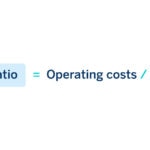The efficiency ratio of a financial institution: what is it and how is it calculated?
To calculate a bank's relative productivity, the market uses what is called an efficiency ratio. This indicator calculates the income earned for the expenses required to achieve said income over a given period of time. An institution's efficiency ratio, expressed as a percentage, is the result of the ratio between operating expenses and the gross margin. For example, if the efficiency ratio is 60% it means that to earn 100 euro, an institution needs to spend 60. Therefore, the lower the percentage, the more efficient the institution.

The efficiency ratio consists of two elements: operating expenses (the numerator) and gross margin (the denominator).
Operating expenses are the expenses incurred by the institution in its business operations. Typically, expenses are divided into three groups: personnel costs, other operating expenses and overheads, also known as 'OPEX' (leases, advertising, water, electricity and gas supplies, IT, among other costs) and depreciation provisions (associated with the impairment or depreciation of physical assets and the amortization of 'CAPEX' or investment).
Gross margin is composed of all the income generated by a financial institution in its business. The most important type of income is so-called recurring income (or core earnings). Net interest income and commissions are the most closely linked to the traditional banking business.

Net interest income is the difference between financial income and financial costs; that is, the difference between an asset's profitability (the credit lines and loans that the institution has on its balance sheet, for example) and the interest that the bank pays for the resources it needs to finance that asset (such as customer deposits and wholesale financing).
The other component of recurring income, commissions, refers to the amounts charged by banks for the provision of services (sale of investment funds, account maintenance, use of cards, structuring of operations, etc. ). They are shown in the net income account of the commissions that the bank in turn pays for other services it receives.
In addition to this so-called recurring income or core earnings, gross margin also includes the net trading income or NTI (including, among others, gains or losses that must be recorded due to asset sales and the mark-to-market of certain assets) and other income (for example, dividends received from the institution's shareholdings in other companies or income from insurance business).
What are operating jaws?
Jaws compare the evolution of income (either gross margin or recurring income) and operating expenses. If revenue grows more than expenses, then these are positive jaws. The same applies the other way around: if expenses grow above income, they are negative jaws. They can be seen as an alternative way of measuring the efficiency of a financial institution.
BBVA, leading the way in efficiency
BBVA has an efficiency ratio of 48.7% as of September 30, 2019 (last public data at this date), and leads the way in the comparison with European banks, which have an average ratio of 63.6% (data from September 2019).